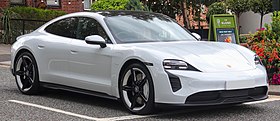| Porsche Taycan | |
|---|---|
 | |
| Overview | |
| Manufacturer | Porsche |
| Model code | Type 9J1 |
| Production | 2019–present |
| Assembly | Germany: Stuttgart |
| Designer |
|
| Body and chassis | |
| Class | Executive car (E) |
| Body style |
|
| Layout | Rear-motor, rear-wheel-drive (Taycan) Dual-motor, all-wheel-drive (Taycan 4, 4S, GTS, Turbo & Turbo S) |
| Platform | Volkswagen Group J1 |
| Related | Audi e-tron GT |
| Powertrain | |
| Engine | 2× AC synchronous electric motors |
| Transmission |
|
| Battery |
|
| Electric range | 333 to 463 km (207 to 288 mi) (WLTP combined), 201 mi (323 km) (EPA) |
| Plug-in charging | |
| Dimensions | |
| Wheelbase | 2,900 mm (114.2 in) |
| Length | 4,963 mm (195.4 in)[5] |
| Width | 1,966 mm (77.4 in) |
| Height | 1,378–1,381 mm (54.3–54.4 in) |
| Kerb weight | 2,140–2,305 kg (4,717.9–5,081.7 lb) |
The Porsche Taycan is a battery electric luxury sports sedan and shooting brake car produced by German automobile manufacturer Porsche. The concept version of the Taycan named the Porsche Mission E, debuted at the 2015 Frankfurt Motor Show.[6] Four years later, the production Taycan was revealed at the 2019 Frankfurt Motor Show.[5] As Porsche's first series production electric car,[6] it is sold in several variants at different performance levels, and may spawn further derivatives in future models.[7] It is built on the J1 electric car platform shared with the similarly shaped Audi e-tron GT.
The name "Taycan" (/taɪ-kan/[8]) is a reference to the steed on the coat of Arms of the city of Stuttgart, found on the Porsche crest. In Turkish, tay means colt or young horse, and can means lively.[9][10] The "Turbo" name used in the higher trims is purely for branding purposes as the vehicles, being electrically powered, do not actually have turbochargers.[11]
- ^ ""The Taycan's proportions are unique"". newsroom.porsche.com. Porsche. 9 April 2019.
- ^ Chong, Jinn Xiung (13 May 2021). "The Porsche Taycan Turbo Is A Supercar On Electric". tatlerasia.com. Tatler Asia. Retrieved 3 August 2023.
- ^ "Mission E: Porsche design of the future". newsroom.porsche.com. Porsche. 24 February 2016.
- ^ Cite error: The named reference
jalop2019-09-06was invoked but never defined (see the help page). - ^ a b Vanderwerp, Dave (4 September 2019). "2020 Porsche Taycan Electric Sports Saloon Is the First Real Threat to Tesla". Car and Driver. Retrieved 4 September 2019.
- ^ a b "Tribute to tomorrow. Porsche Concept Study Mission E. - Dr. Ing. h.c. F. Porsche AG".
- ^ "Porsche Mission E due with Level 4 autonomy and 15min fast-charging". autocar.co.uk. Retrieved 28 March 2018.
- ^ "How to pronounce Taycan". YouTube.
- ^ Valdes-Dapena, Peter. "Porsche's first electric car will be called the Taycan". CNNMoney. Retrieved 11 June 2018.
- ^ "Mission E becomes Taycan". newsroom.porsche.com. Retrieved 8 June 2018.
- ^ "#AskPorsche - The name Turbo". youtube.com. Retrieved 7 September 2020.